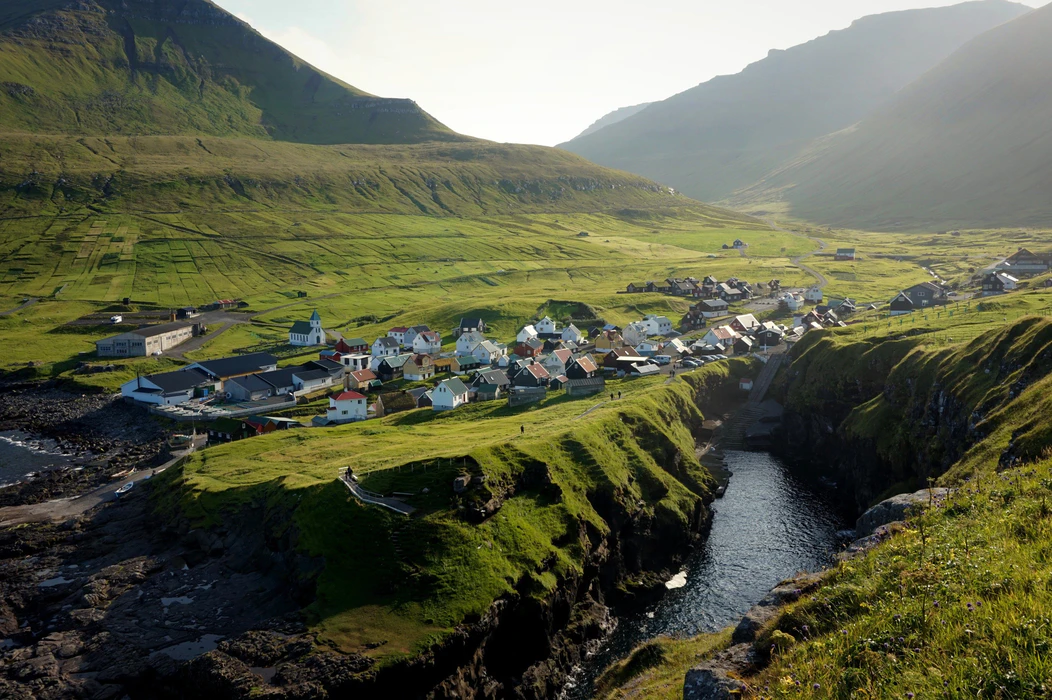NordenBladet – What is Faroe Islands famous for? They are famous for their peaceful community, unique culture with old ballads and chain-dance, hospitality and cosmopolitanism. More quick facts and intresting question-answers below.
Name: The Faroe Islands (Føroyar)
Location: In the middle of the Gulf Stream in the North Atlantic at 62º00’N and 06º47’W, halfway between Scotland and Iceland
Neighbouring countries: Closest land is North Rona, part of Scotland’s Outer Hebrides, 257km (139 nautical miles) to the south
Total land area: 1,399km2 (540 square miles)
Total marine area: 247,000km2 (105,792 square miles)
Area: Faroese archipelago, 113km (70 miles) long and 75km (47 miles) wide. Total coastline of 1,100km (687 miles). No point in the Faroe Islands is further than 5km (3 miles) from the sea.
Islands: 18 volcanic islands separated by narrow sounds and fjords arranged roughly in the form of an arrowhead. All but one are inhabited.
Heights: Highest peak 880m (2,887ft); average height above sea level 300m (980ft)
Climate: Average 3º-11ºC, winter-summer
Population: 52,656 (as of July ’20)
Capital: Tórshavn (population 22,216 as of July ’20)
Status: Self-governing region within Kingdom of Denmark
Language: Faroese. Danish has equal status in all official affairs
Religion: Evangelical Lutheran
Government: Parliamentary democracy
Prime Minister: Bárður á Steig Nielsen (Union Party, Sambandsflokkurin)
Anthem: Tú alfagra land mítt
Main industries: Fishing and aquaculture, shipping and offshore services, tourism and prospects for petroleum in Faroese area
Currency: Faroese króna (DKK)
Exchange rate: £1 = 8.27kr, US$1 = 6.31kr, €1 = 7.45kr (August 2020)
International telephone code: +298
Internet TLD: .fo
Time: GMT (winter); GMT+1 (summer)
Electrical voltage: 220V; European two-pin plugs
Weights and measures: Metric
Flag: Red cross fringed with blue on white background
Public holidays: New Year’s Day 1 January, Maundy Thursday, Good Friday, Easter Sunday, Easter Monday, Flag Day 25 April, Common Prayers’ Day (May), Ascension Day, Whit Sunday, Whit Monday, Ólavsøka 28-29 July, Christmas 24-26 December, New Year’s Eve 31 December
The population of the Faroe Islands totals at 52,656 people, the highest in history, with nearly half living in the capital, Tórshavn. With a fertility rate of 2.4, the Faroe Islands has a higher fertility rate than any other European country. Life expectancy for men is 80.4 years and 85.3 years for women.
How old are the Faroe Islands?
Norsemen settled the Faroe Islands in the 9th century or 10th century. The islands were officially converted to Christianity around the year 1000, and became a part of the Kingdom of Norway in 1035.
Is Faroe Island Expensive?
The Faroes have a reputation for being pretty expensive – but with a little forward planning and some smart budgeting, your travels there absolutely don’t need to break the bank. As with most places, your biggest expense here is accommodation, and sadly it really is unavoidably expensive here!
Do they speak English in the Faroe Islands?
The national language of the Faroe Islands is Faroese. Danish is the official second language and is taught in schools at an early age. English is the also taught in schools and is spoken by most people.
What is Faroe Island known for?
National Geographic recently elected the Faroe Islands as the world’s most appealing island community, out of 111 island destinations worldwide. They are noted for their friendliness.
Who owns Faroe Island?
The Faroe Islands are a self-governing nation under the external sovereignty of the Kingdom of Denmark.
What is the best time of year to visit the Faroe Islands?
June through August is the most popular time to visit the Faroe Islands. Not only is the weather warmer, more settled and less wet than during winter, but the days are long, promising 19 hours 45 minutes of daylight on 21 June (the longest day).
Are the Faroe Islands safe?
The Faroe Islands have nearly no crime, making it one of the safest places on earth to travel to. You can rest assured that you are safe at all times, both day and night. The health risks involved in travelling in the Faroe Islands are minimal and there is no need to take special precautions.
Featured image: Gjógv, Faroe islands (Unsplash)
Read also:
Scandinavian history & Norse culture: Viking-era longhouses and burial mounds
Picturesque travel destinations in Faroe Islands: Múlafossur Waterfall and the Island of Vágar
EXHAUSTIVE OVERVIEW: who were the ancient Scandinavian origin Vikings and when was the time of the Vikings?
Faroe Islands: Streymoy and Kvívík offer a wealth of natural beauty, cultural heritage, and outdoor activities
Experience the extreme North! Travel & culture guide: WHAT to do in the Faroe Islands?
